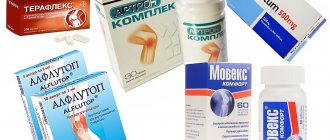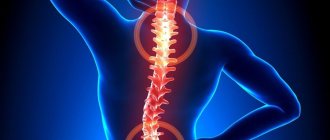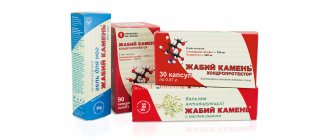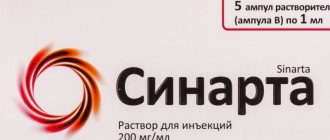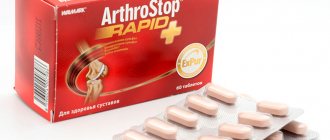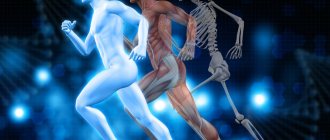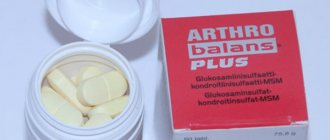Pharmacological properties
Artiflex
Pharmacodynamics. Artiflex is a drug that affects metabolism in cartilage tissue. Glucosamine sulfate is a salt of the natural aminomonosaccharide glucosamine with low molecular weight, carefully purified from macromolecular components. The drug replenishes the endogenous deficiency of glucosamine and stimulates the synthesis of hyaluronic acid proteoglycans in synovial fluid. Increases the permeability of the joint capsule, restores enzymatic processes in the cells of the synovial membrane and articular cartilage. The anti-inflammatory effect of glucosamine sulfate is due to blocking the formation of superoxide radicals by macrophages and inhibition of lysosomal enzymes. The drug promotes the fixation of sulfur in the process of chondroitinsulfuric acid synthesis, facilitates the absorption of calcium in bone tissue, inhibits the development of degenerative processes in the joints, restores their function, reducing the severity of joint pain. Sulfates are also involved in the synthesis of glycosaminoglycans and the metabolism of cartilage tissue. The sulfate ester side chains of proteoglycans are important for maintaining the elasticity and water retention capacity of the cartilage matrix. The severity of clinical symptoms usually decreases 2 weeks after the start of treatment, with the effect maintaining for 8 weeks after discontinuation of the drug.
Pharmacokinetics. Glucosamine sulfate is quickly and completely absorbed in the small intestine (90%). Easily passes through biological barriers and penetrates tissue, mainly articular cartilage. T½ - 68 hours.
Artiflex chondro
Pharmacodynamics. The main active ingredients of the drug are sodium salt of chondroitin sulfate A and C (average molecular weight - 11,000 Da). Chondroitin sulfate is a high molecular weight mucopolysaccharide, which is the main component of proteoglycans, which, together with collagen fibers, form the cartilage matrix.
The drug inhibits the process of degeneration and stimulates the regeneration of cartilage tissue, has chondroprotective, anti-inflammatory, analgesic properties; replaces chondroitin sulfate in articular cartilage catabolized by the pathological process; inhibits the activity of enzymes that cause degradation of articular cartilage: inhibits metalloproteinase, namely leukocyte elastase; reduces hyaluronidase activity; partially blocks the release of free oxygen radicals; helps block chemotaxis and antigenic determinants; stimulates the synthesis of proteoglycans by chondrocytes; affects phosphorus-calcium metabolism in cartilage tissue; allows you to restore the mechanical and elastic integrity of the cartilage matrix. Anti-inflammatory and analgesic effects are achieved by reducing the release of inflammatory mediators and pain factors into the synovial fluid through synoviocytes and macrophages of the synovial membrane, as well as by inhibiting the secretion of leukotriene B and prostaglandin E.
The drug helps restore the joint capsule and cartilaginous surfaces of the joints, reduce pain intensity, prevents compression of connective tissue, acts as a lubricant for articular surfaces, normalizes the production of joint fluid, improves joint mobility and quality of life.
Artiflex chondro slows down bone resorption and reduces calcium loss, accelerating the process of bone tissue restoration.
Pharmacokinetics. After intramuscular administration, chondroitin sulfate penetrates into the synovial fluid. Cmax in synovial fluid is achieved 4–5 hours after injection. It is excreted from the body within 24 hours. Eliminated mainly by the kidneys.
Application
Artiflex
Use internally.
Adult patients and elderly people: the contents of 1 packet are equivalent to 1.5 g of glucosamine sulfate, dissolve in a glass of water and take 1 time per day, preferably with meals.
The course of treatment is 4–12 weeks or longer (if necessary). As prescribed by a doctor, therapy can be repeated 2-3 times a year with an interval of 2 months, as well as in case of relapse of the disease.
Artiflex chondro
The drug is administered to adults intramuscularly, 1 ml every other day. If well tolerated, the dose is increased to 2 ml, starting with the 4th injection. The course of treatment is 25–35 injections. Repeated courses - after 6 months.
Analogs
If necessary, Artiflex can be replaced with an analogue drug. Listed below are medications with similar compositions available in Russian and/or Ukrainian pharmacies:
| for oral use: | for topical use: |
|
|
Side effects
Artiflex
From the gastrointestinal tract: stomach pain, flatulence, diarrhea, constipation, nausea, vomiting.
From the nervous system: headache, drowsiness, general weakness.
From the immune system: allergic reactions in the form of various skin rashes and itching.
From the organ of vision: visual impairment.
Skin: hair loss.
Artiflex chondro
When using the drug in persons with hypersensitivity to the drug, the following violations are possible:
from the immune system: allergic reactions, anaphylactic shock, angioedema;
from the skin and subcutaneous tissue: rash, itching, erythema, urticaria, dermatitis, alopecia; redness and itching are possible at the injection site;
from the gastrointestinal tract: nausea, vomiting, abdominal pain, flatulence, dyspeptic symptoms;
others: visual disturbances, keratopathy, dizziness, peripheral edema.
special instructions
Use during pregnancy or breastfeeding. do not apply.
Children. The drug is not used.
The ability to influence reaction speed when driving vehicles or working with other mechanisms. Does not affect.
Artiflex
As a result of the fact that glucosamine is derived from shellfish shells, patients with shellfish allergies should take Artiflex with caution.
Powder for oral use contains sorbitol. Patients with a rare hereditary form of fructose intolerance are not recommended to use the drug in this dosage form.
Patients on a sodium-controlled diet should take into account the sodium content of the oral dosage form (151 mg per 1500 mg daily dose).
At the beginning of treatment for patients with diabetes mellitus, it is advisable to monitor blood glucose levels.
In patients with severe liver or kidney failure, the drug is used only under medical supervision.
Artiflex is contraindicated for patients with phenylketonuria because it contains aspartame.
Artiflex chondro
To achieve a stable clinical effect, at least 25 injections of the drug are required. The effect lasts for many months after the end of treatment. To prevent exacerbations, repeated courses of treatment are used. It is recommended to increase the dose under the supervision of a physician for patients with excess body weight, gastric or duodenal ulcers, while taking diuretics, as well as at the beginning of treatment if a rapid clinical response is necessary.
In case of allergic reactions or hemorrhages, treatment should be stopped.
Reviews
Reviews about the effectiveness of Artiflex are positive. Artiflex is often prescribed for degenerative-dystrophic pathologies of the spinal column and joints.
Patients praise the effectiveness of the drug, the duration of its action (the effect lasts for several months), and the almost complete absence of side effects.
The only negative point is the high cost of the medication.
If you go to the end of the article, you can see people's reviews about Artiflex.
There (if desired) you can share your opinion about the cream and powder.
By doing this you will provide an invaluable service to other site visitors.
Interactions
Artiflex
With combined use, an increase in the effect of coumarin anticoagulants was noted. In this regard, it is advisable for patients to monitor coagulation parameters.
It is possible to increase the gastrointestinal absorption of tetracycline. The drug is compatible with NSAIDs and GCS.
Artiflex chondro
When used simultaneously with GCS and NSAIDs, chondroitin sulfate can reduce the need for their use, as well as for painkillers. It has a synergistic effect when used simultaneously with glucosamine and other chondroprotectors. The effectiveness of treatment increases when the diet is enriched with vitamins A, C and salts of manganese, magnesium, copper, zinc and selenium.
When taken simultaneously with acetylsalicylic acid or other anticoagulants or antiplatelet agents, it is recommended to monitor blood clotting.
Actual information
Artiflex is a complex drug for the treatment of pathologies of the musculoskeletal system. For the most effective use, it is available in two forms - a cream for topical use and a soluble powder for oral administration.
Mechanism of action and therapeutic effects of glucosamine
The main active ingredient of Artiflex
, powder for oral solution, is glucosamine hydrochloride.
Glucosamine is an aminosaccharide, that is, in chemical composition it is a low molecular weight derivative of carbohydrates with the inclusion of an amino group. It is synthesized from glucose and utilized in the reactions of glycosaminoglycan and proteoglycan synthesis (Dahmer S., 2008). Glucosamine is involved in many biochemical processes in the body, including the synthesis of chondroitin. In modern pharmacology, glucosamine is presented in the form of two compounds: glucosamine hydrochloride and glucosamine sulfate. Glucosamine sulfate requires additional stabilizer components, so its purity is 74%. Glucosamine hydrochloride has no sulfate group, which helps achieve 99% purity. That is why, in terms of the pure active ingredient, glucosamine hydrochloride at a dose of 1500 mg is equivalent to 2608 mg of glucosamine sulfate (Owens S., 2004), although the difference in bioavailability between these two forms is so insignificant that it is not taken into account in clinical practice (Aghazadeh-Habashi A. , 2011). Glucosamine is easily absorbed by the gastrointestinal mucosa and is quickly metabolized in the liver (the “first pass” effect), and is excreted from the body in feces or urine. Peak concentrations of the drug in the blood are observed within 8 hours after oral administration. The half-life of the drug is quite long - 68 hours. This is primarily due to the high degree of binding of glucosamine to proteins - about 90% (Fox BA, 2007). The bioavailability of glucosamine is 26% (Barclay TS, 1998).
Since glucosamine is a structural component of the cartilage matrix of joints, traditionally the treatment of articular pathology has been associated with its additional supply from the outside. Subsequently, studies were carried out on the biochemical principles of glucosamine action. The mechanism of its anti-inflammatory effect is based on the inhibition of pro-inflammatory mediators such as NO, cyclooxygenase (COX)-2 and matrix metalloproteinases. In addition, the same effect is associated with the reduction of nuclear factor κβ, which is induced by interleukin-1 (Gouze JN, 2006). Studies (Nakamura H., 2004) also demonstrated that glucosamine inhibits the production of catabolic enzymes and inflammatory markers (for example, prostaglandin E2) by chondrocytes and synovial cells stimulated by interleukin-1.
In addition, glucosamine is a precursor of glycosaminoglycans (in particular hyaluronic acid and keratan sulfate) and proteoglycans, which are found in articular cartilage, intervertebral disc and synovial fluid (Henrotin Y., 2012). This property is also used in cosmetology - by increasing the synthesis of hyaluronic acid, glucosamine accelerates wound healing, moisturizes the skin and helps reduce the number of wrinkles (Bissett DL, 2006). In addition, it acts as a tyrosinase inhibitor, that is, it indirectly reduces the production of melanin, and therefore helps to resist the development of hyperpigmentation.
Studies (Hua J., 2005) have proven that local use of glucosamine significantly reduces the severity of adjuvant arthritis (an experimental model of arthritis of any joint in the body, which in its pathogenesis is close to rheumatoid arthritis).
According to a Cochrane review (Towheed T., 2009), glucosamine is the drug of choice in the treatment of osteoarthritis, as it improves joint function, increases the range of active and passive movements (da Camara CC, 1998), reduces the severity of pain and hyperesthesia, as well as probably does not cause side effects. The FDA classifies glucosamine as a dietary supplement, but this drug is characterized by the ability to reduce pain, inhibit the progression of damage and even restore cartilage in patients with osteoarthritis or other joint diseases (Kirkham SG, 2009). Real-time studies (Bruyère O., 2016) demonstrate that systematic use of glucosamine in patients with osteoarthritis delays the need for additional painkillers. It promotes the restructuring of not only cartilage and synovial tissue, but also subchondral areas of bone (Henrotin Y., 2012).
When choosing a therapeutic dose, it should be taken into account that to achieve an effect when used systemically (for example, in the form of tablets or powder for preparing a solution), the daily dose of glucosamine must be at least 1500 mg. However, a tablet containing 1.5 g of active substance may seem very large to the patient, and several tablets of a smaller size (and therefore with less active substance) may give the subjective impression of an overdose with subsequent non-compliance by the patient with the doctor’s prescriptions (Aghazadeh-Habashi A., 2011 ). That's why Artiflex
Available in powder form for preparing a solution. One dose contains the equivalent of 1500 mg of glucosamine. A portion of the powder is dissolved in a glass of clean water and consumed orally once a day. To achieve a sustainable therapeutic effect, the drug must be taken in long courses - 4-12 weeks each. Such courses can be repeated 2-3 times a year, with an interval of 2 months between courses.
Possible areas of application of glucosamine-based drugs:
– cervical spondylosis (Li Y., 2018);
– osteochondrosis (localized or widespread);
– osteoarthritis (Matheson AJ, 2003), especially of the hip and knee joint;
– other inflammatory and degenerative diseases of the musculoskeletal system;
– after surgical interventions on joints, including meniscus repair and total endoprosthetics;
– due to its healing properties, glucosamine can be used as an adjuvant for the treatment of inflammatory bowel diseases (for example Crohn's disease) (Bissett DL, 2006);
– glucosamine is used in cosmetology to reduce skin pigmentation and reduce the number of wrinkles (Bissett DL, 2006).
Artiflex
cream The main therapeutic effect is achieved by using glucosamine orally in the form of a powder to prepare a solution. For maximum results in the treatment of osteoarthritis, an integrated approach is required, which includes not only pharmacotherapy, but also therapeutic exercises, physiotherapy, skeletal traction, as well as lifestyle changes (weight loss, dietary review). Artiflex cream locally.
.
The cream is applied to the skin surrounding the affected joint 2-3 times a day and rubbed in for several minutes until completely absorbed. To achieve a sustainable effect, the course of topical application of Artiflex
should be at least 2 weeks. The cream, in addition to glucosamine hydrochloride, contains ibuprofen and allantoin, which enhance its effect. In addition, for more effective penetration of the drug into tissues, a specialized carrier, methylpyrrolidone, is used.
Methylpyrrolidone is a drug from the ketopyrroles group. In its chemical structure it is close to β-lactams, and in addition it is a universal solvent. In medicine, it is used as an inert universal carrier for transdermal penetration, that is, it improves the penetration into tissues of substances that are applied to the skin (Ameen D., 2017). It has moderate immunomodulatory activity, which causes a potentiation of the therapeutic effect in local inflammatory processes. This substance is non-toxic and non-carcinogenic for humans (Schortt J., 2014), however, if Artiflex
If used in the form of a cream for a long time and in large quantities, a peculiar yellow coloration of the urine may be observed.
Ibuprofen belongs to the group of non-steroidal anti-inflammatory drugs and is a derivative of propionic acid. Its anti-inflammatory and analgesic effect is based on inhibition of the synthesis of prostaglandins E and F, and the action occurs both at the peripheral and central levels. This mechanism is realized by indiscriminately blocking the enzymes COX-1 and COX-2. By reducing the synthesis of prostaglandins, the severity of such manifestations of the inflammatory process as hyperemia and pain decreases. Moreover, the analgesic effect is achieved through a complex mechanism: prostaglandins increase the irritability of sensitive nerve fibers (Ershad M., 2019). In addition, the antiplatelet activity inherent in ibuprofen improves local capillary blood flow.
Allantoin is an anti-inflammatory agent of plant or animal origin. Today, it is most often obtained by extracting from the roots of the comfrey plant (Symphytum), more popularly known as larkspur. This remedy is also known for its astringent and analgesic, antioxidant and cytoprotective properties (da Silva DM, 2018). The analgesic effect of allantoin is achieved through its effect on peripheral opioid receptors (Florentino IF, 2016). In addition, allantoin is characterized by such effects as reducing irritation, keratolytic activity, and stimulating cell mitosis (Araujo A., 2010).
Features of application
Since glucosamine is a low molecular weight derivative of carbohydrates, it can probably be involved in carbohydrate metabolism processes and affect blood glucose levels. Experiments on animals have proven that glucosamine is included in the processes of glucose metabolism through the biosynthesis of hexosamine (Dostrovsky NR, 2011). In addition, the results of experimental studies on animals (Kajinuma H., 1975) demonstrate an increase in the blood level of immunoreactive glucagon (which is a counter-insular hormone) when exogenous glucosamine is introduced into the body.
Thus, the use of glucosamine requires caution in patients with diabetes (Stumph JL, 2006). In such cases, it is recommended to monitor the level of glucose and glycosylated hemoglobin in the blood, as well as adjust the dose of insulin or other glucose-lowering drugs.
In addition, since glucosamine in the modern pharmaceutical industry is produced by hydrolysis of the exoskeletons of crustaceans, it is necessary to prescribe it with caution to patients with food allergies to fish and shellfish (Dahmer S., 2008).
There are isolated reports of glucosamine potentiating the action of warfarin (Dahmer S., 2008), so patients receiving anticoagulants require monitoring of blood coagulation parameters.
Since high doses of methylpyrrolidone are characterized by teratogenic effects (Shortt J., 2014), the use of Artiflex
Contraindicated during pregnancy.
Thanks to the local application of ibuprofen in Artiflex
its systemic impact is small. However, it is necessary to remember the undesirable effects characteristic of all non-steroidal anti-inflammatory drugs: gastropathic manifestations (pain in the stomach, nausea, heartburn), decreased blood clotting, and nephrotoxicity.
Since glucosamine is a non-toxic substance, cases of overdose of the drug Artiflex
not recorded.
But patients should keep in mind that short-term exceeding the recommended dose will not lead to an increase in the therapeutic effect. This is due to the fact that the regeneration of cartilage and synovial tissue occurs slowly - over several months. Conclusion
Degenerative-dystrophic diseases of the musculoskeletal system are one of the leading medical and social problems in the modern world. Osteoarthritis in the general population affects approximately 10% of men and 18% of women over the age of 60 years (OARSI, 2016), with 80% of these having mobility limitations that significantly impair quality of life. It is worth noting that the incidence of osteoarthritis is steadily increasing due to the aging population and the rising prevalence of obesity (ESCEO, 2019). The search for optimal treatment strategies for osteoarthritis involves reducing the severity of symptoms and, ultimately, slowing the progression of the pathology.
The use of glucosamine-based drugs is of interest due to their effects aimed at maintaining normal cartilage structure and joint function along with alleviating the symptoms of the disease. Two forms of the drug Artiflex
allow you to create a convenient therapeutic combination that provides both systemic and local effects on the pathological process in diseases of the musculoskeletal system.
And the absence of the risk of overdose and the minimum of side effects make Artiflex
a promising drug for long-term use.
Product description certified by the manufacturer Health
.
Verified
Sevryukov Alexander Viktorovich
Artiflex ultra, capsules No. 60 - Instructions
DOSAGE FORM
Capsules in a package of 60 pieces.
COMPOUND
Active ingredients: glucosamine, chondroitin sulfate, ibuprofen;
1 capsule contains glucosamine sulfate sodium chloride in terms of glucosamine sulfate 250 mg, sodium chondroitin sulfate 200 mg, ibuprofen 100 mg.
Excipients: corn starch, crospovidone, sodium starch (type A), stearic acid, microcrystalline cellulose, magnesium stearate, povidone, colloidal silicon dioxide; capsule shell contains gelatin, titanium dioxide (E 171).
PHARMACOLOGICAL GROUP
Combined anti-inflammatory (anti-inflammatory) drugs.
PHARMACOLOGICAL PROPERTIES
Pharmacological.
This drug stimulates the regeneration of cartilage tissue. It has an anti-inflammatory effect at the cellular level, stimulates the synthesis of both endogenous proteoglycans and endogenous hyaluronic acid, reduces the catabolic activity of chondrocytes by inhibiting some enzymes that destroy cartilage, such as collagenase, elastase, proteoglykinase, phospholipase-A2, N-acetylglycosaminidase, etc. , and also inhibits the formation of other substances that can damage cartilage tissue (in vitro), such as superoxide radicals; activity of lysosomal enzymes.
Chondroitin and glucosamine are effective in patients with osteoarthritis.
Chondroitin is one of the main elements of cartilage. It reduces the activity of the inflammatory process in the early stages and thus slows down the degeneration of cartilage tissue. Helps reduce pain, improve joint function and reduce the need for NSAIDs for osteoarthritis of the knee and hip joints.
Glucosamine is physiologically present in the human body and has chondroprotective properties. In vitro and in vivo studies have shown that glucosamine hydrochloride stimulates the synthesis of physiological glycosaminoglycans and proteoglycans by chondrocytes and the synthesis of hyaluronic acid by synoviocytes.
Ibuprofen has antipyretic, analgesic and anti-inflammatory effects. The mechanism of action is associated with non-selective blocking of cyclooxygenase (COX) types 1 and 2 (the main enzyme in the metabolism of arachidonic acid), which leads to a decrease in the synthesis of prostaglandins, a decrease in their concentration in the cerebrospinal fluid and a weakening of the excitation of the thermoregulatory center. Reduces morning stiffness, helps increase range of motion in joints and spine.
The combined use of glucosamine and ibuprofen leads to an increase in the level of analgesic activity of the latter.
Pharmacokinetics.
After a single dose of a therapeutic dose, the maximum level of chondroitin sulfate in the blood plasma is achieved after 3-4 hours. The bioavailability of the dose that was administered orally is 12%.
In the blood, 85% of chondroitin and its depolymerized derivatives are bound to several plasma proteins.
At least 90% of a dose of chondroitin is first metabolized by lysosomal phosphatases, after which it is depolymerized by hyaluronidase, β-glucuronidase and β-N-acetylhexosaminidase in the liver, kidneys and other organs.
Chondroitin and its depolymerized derivatives are eliminated primarily by renal excretion. The half-life ranges from 5 to 15 hours.
After oral administration, glucosamine hydrochloride is rapidly and almost completely absorbed from the intestine. The pharmacokinetics of glucosamine is linear when used in doses up to 1500 mg 1 time per day, and high doses will not lead to a proportionally higher increase in the maximum concentration of glucosamine.
More than 25% of the taken dose of glucosamine passes from the blood plasma into the cartilage tissue and synovial joint membrane.
According to the first pass effect in the liver, more than 70% of glucosamine is metabolized to urea, carbon dioxide and water.
It is excreted unchanged mainly by the kidneys in urine and partially in feces. The half-life is 68 hours.
After oral administration, ibuprofen is almost completely absorbed from the gastrointestinal tract. Concomitant food intake delays absorption. Ibuprofen is metabolized in the liver (90%). The half-life is 2-3 hours. 80% of the dose is excreted in the urine, mainly in the form of metabolites.
INDICATIONS FOR USE
Treatment of pain in primary and secondary osteoarthritis of the joints of the limbs and intervertebral discs.
METHOD OF APPLICATION AND DOSES
The drug should be taken after meals with a glass of water.
Adults take 2 capsules 3 times a day.
Do not exceed the maximum daily dose of 12 capsules (1.2 g ibuprofen).
The duration of treatment at the recommended dose should not exceed 20 days. After the pain disappears, the patient can continue treatment with Artiflex Plus tablets.
CONTRAINDICATIONS
This medicine is contraindicated in the following cases:
- hypersensitivity to the active substances or other components of the drug
- a history of allergic reactions (such as bronchospasm, asthma, rhinitis or skin rashes, angioedema, urticaria associated with the use of acetylsalicylic acid or other NSAIDs);
- history of gastrointestinal bleeding or perforation after using NSAIDs
- gastric ulcer / bleeding currently or in history (two or more clear episodes of exacerbation of peptic ulcer and bleeding)
- optic nerve diseases;
- hematopoiesis disorder;
- severe renal, cardiac or liver failure
- phenylketonuria;
- cerebrovascular or other bleeding
- diabetes
- tendency to bleed;
- thrombophlebitis.
The use of the drug simultaneously with other NSAIDs, including selective cyclooxygenase-2 (COX-2) inhibitors, is contraindicated.
INTERACTIONS WITH OTHER MEDICINES AND OTHER TYPES OF INTERACTIONS
Medicines, when used simultaneously with the drug Artiflex Ultra, capsules, an interaction may occur
Ibuprofen
Such combinations with ibuprofen should be avoided.
Acetylsalicylic acid
May increase the risk of side effects. Allowed provided that the dose of acetylsalicylic acid not exceeding 75 mg per day was prescribed by a doctor.
Other NSAIDs, including selective COX-2 inhibitors
The risk of erosive and ulcerative lesions and gastrointestinal bleeding increases (see Section “Contraindications”).
The following combinations with ibuprofen should be used with caution:
Cyclosporine
The risk of nephrotoxicity may increase.
Lithium
The level of lithium in the blood plasma increases.
Methotrexate at a dose of 15 mg/week or higher
The concentration of methotrexate increases and the risk of toxic effects of methotrexate increases.
Anticoagulants
NSAIDs may enhance the effects of anticoagulants such as warfarin.
Corticosteroids
Increased risk of gastrointestinal bleeding or ulceration.
Antihypertensives and diuretics
NSAIDs may reduce the therapeutic effect of these drugs.
In some patients with impaired renal function (eg, dehydrated patients or elderly patients with impaired renal function), concomitant use of ACE inhibitors (ACE inhibitors) or angiotensin II antagonists and agents that inhibit COX may cause further deterioration of renal function, including possible renal failure, potentially reversible. The possibility of such an interaction should be considered in patients taking coxibs concomitantly with ACE inhibitors or angiotensin II antagonists. Therefore, this combination should be used with caution, especially in elderly patients. Patients should receive adequate fluids and consideration should be given to monitoring renal function during the initiation of concomitant treatment and periodically thereafter. Diuretics may increase the risk of NSAID nephrotoxicity.
Antiplatelet drugs and selective serotonin reuptake inhibitors
The risk of gastrointestinal bleeding increases.
Cardiac glycosides
NSAIDs can worsen heart failure, reduce glomerular filtration rate, and increase the level of glycosides in the blood.
Zidovudine
When NSAIDs are taken concomitantly with zidovudine, the risk of hematological toxicity increases. There is evidence of an increased risk of hemarthrosis and hematoma in HIV-infected patients receiving concomitant treatment with zidovudine and ibuprofen.
Mifepristone
NSAIDs are not used earlier than 8-12 days after using mifepristone, as they reduce its effectiveness.
Tacrolimus
There may be an increased risk of nephrotoxicity with concomitant use of NSAIDs and tacrolimus.
Potassium-sparing diuretics
Hyperkalemia may occur.
Alcohol
Increased risk of gastrointestinal damage and increased bleeding time.
Quinolone antibiotics
Concomitant use of NSAIDs and quinolone antibiotics may increase the risk of seizures.
Sulfonylureas and phenytoin
The effect of the drugs may be enhanced.
Tetracycline
The absorption of tetracycline from the gastrointestinal tract increases.
Penicillin
The absorption of penicillin is reduced.
Chloramphenicol
The absorption of chloramphenicol is reduced.
Cyclosporine
May affect cyclosporine blood concentrations.
The physicochemical and pharmacokinetic properties of chondroitin and glucosamine indicate a low potential for interactions; specific interaction studies have not been conducted. Chondroitin and glucosamine are compatible with NSAIDs.
It has been recorded that with the simultaneous use of glucosamine and warfarin, the effect of the latter may be enhanced and bleeding may develop. Therefore, during simultaneous use it is necessary to monitor blood coagulation parameters.
APPLICATION FEATURES
Avoid using Artiflex Ultra concomitantly with other NSAIDs, including selective COX-2 inhibitors, due to the increased risk of ulcers or bleeding, as well as other adverse reactions. Adverse reactions can be minimized by taking the lowest effective dose for the shortest amount of time necessary to control symptoms.
Gastrointestinal bleeding, ulceration or perforation, which may be fatal, with or without prior symptoms, has been reported for all NSAIDs at any time during treatment, regardless of a history of severe gastrointestinal complications.
The risk of gastrointestinal bleeding, ulceration or perforation increases with increasing doses of NSAIDs, with a history of ulcers, including those complicated by bleeding or perforation, and in elderly patients. Such patients should begin treatment with the lowest available dose. Combination treatment with protective drugs (particularly misoprostol or proton pump inhibitors) should be considered in these patients, as should patients who require concomitant use of low doses of acetylsalicylic acid or other drugs that may increase gastrointestinal risk.
Patients with a history of gastrointestinal disorders, especially elderly patients, should report any unusual abdominal symptoms (in particular gastrointestinal bleeding) to the physician, especially in the early stages of treatment. Caution should be exercised when treating patients concomitantly receiving drugs that may increase the risk of ulceration or bleeding, such as oral corticosteroids, anticoagulants such as warfarin, selective serotonin reuptake inhibitors, and antiplatelet agents such as acetylsalicylic acid.
If patients receiving ibuprofen develop gastrointestinal bleeding or ulceration, treatment should be discontinued.
NSAIDs should be used with caution in patients with a history of ulcerative colitis or Crohn's disease, as their condition may worsen.
If acetylsalicylic acid is used to suppress platelet aggregation, you should consult your doctor before starting treatment with Artiflex Ultra.
There is evidence that drugs that inhibit COX/prostaglandin synthesis may impair female fertility through effects on ovulation. This can be corrected by stopping these medications.
The use of ibuprofen, especially in high doses (2400 mg/day) during long-term treatment, may be associated with a slight increase in the risk of arterial thrombotic complications (eg myocardial infarction or stroke). Low doses of ibuprofen (≤ 1200 mg/day) are not associated with an increased risk of myocardial infarction.
For patients with uncontrolled hypertension, congestive heart failure, diagnosed coronary artery disease, peripheral arterial disease and/or cerebrovascular disease, long-term treatment should only be prescribed by a physician after careful analysis. In patients with significant risk factors for cardiovascular complications (such as hypertension, hyperlipidemia, diabetes mellitus, smoking), long-term treatment with NSAIDs should be prescribed only after careful consideration.
Very rarely, severe skin reactions, some fatal, have been reported with NSAIDs, including exfoliative dermatitis, Stevens-Johnson syndrome and toxic epidermal necrolysis. Obviously, the highest risk of such reactions is in the early stages of treatment: the onset of such a reaction in most cases was observed during the first month of treatment. Treatment with ibuprofen should be discontinued at the first sign of skin rash, mucosal ulceration or any other sign of hypersensitivity.
Ibuprofen may cause bronchospasm and asthma attacks or other hypersensitivity reactions. Risk factors for such reactions include pre-existing asthma, hay fever, nasal polyps, sensitivity to acetylsalicylic acid or chronic respiratory diseases. This also applies to patients who experience allergic reactions to ibuprofen or other NSAIDs (in particular skin reactions, itching, urticaria).
It is not recommended to drink alcohol during treatment with Artiflex Ultra.
Use with caution in patients with:
- systemic lupus erythematosus and systemic connective tissue diseases - increased risk of aseptic meningitis;
- history of arterial hypertension and/or heart failure, which were accompanied by fluid retention and edema when using NSAIDs
- impaired renal and/or liver function; liver dysfunction increases the risk of renal toxicity and injury, as well as severe and potentially fatal liver reactions. For patients with liver or kidney disease, additional examinations are recommended before starting treatment: monitoring liver and kidney function and peripheral blood tests.
Long-term use of NSAIDs can lead to a dose-dependent decrease in prostaglandin synthesis and provoke the development of renal failure. Patients taking diuretics are at high risk; patients with impaired liver function, kidney function and / or cardiac disorders; elderly patients.
Features of the use of glucosamine sulfate and chondroitin sulfate
The drug should not be used in patients with hypersensitivity (allergy) to seafood.
An exacerbation of asthma symptoms is possible in patients with a history of bronchial asthma after starting treatment with glucosamine.
Rarely, edema and/or water retention in the body have been observed in patients with heart and/or renal failure. This may be due to the osmotic effect of chondroitin sulfate.
You should contact your doctor if your symptoms worsen after starting this drug.
Use during pregnancy or breastfeeding. Although the use of drugs containing ibuprofen is contraindicated only during the third trimester of pregnancy, there are no clinical data regarding the effectiveness and safety of glucosamine sulfate during pregnancy or lactation. Therefore, it should not be used during these periods.
ABILITY TO INFLUENCE REACTION SPEED WHEN DRIVING VEHICLES OR OTHER MECHANISMS
The patient should monitor changes in his reaction speed before driving or operating machinery. If any adverse effects from the nervous system are detected, you should stop driving vehicles or using other mechanisms.
CHILDREN
There is no experience with the use of the drug in children (under 18 years of age).
OVERDOSE
In case of overdose, abdominal pain, nausea, vomiting, diarrhea, gastrointestinal bleeding, dizziness, headache, sleep disturbance and tinnitus may occur. In severe cases, symptoms from the nervous system may occur: drowsiness, lethargy, occasionally - agitation and disorientation, loss of consciousness or coma, possible arterial hypertension, arterial hypotension, impaired liver and kidney function or hepatonecrosis, acute renal failure, rhabdomyolysis and hypothermia; respiratory failure and cyanosis. Occasionally, in case of overdose, convulsions are observed. In patients with bronchial asthma, exacerbation of asthma is possible. In severe overdose, metabolic acidosis (including renal tubular acidosis) and hypokalemia may develop, and the prothrombin time/INR may be prolonged, probably due to interactions with coagulation factors.
Treatment is symptomatic, aimed at ensuring the vital functions of the body, including ensuring airway patency, and normalizing the condition. It is recommended that gastric lavage and oral administration of activated carbon be performed within 1:00 after administration of a potentially toxic dose of the drug (more than 400 mg/kg) and hospitalization in the toxicology department. At the inpatient stage, infusion therapy, forced diuresis, and symptomatic treatment are used. There are no special antidotes. Frequent or prolonged seizures should be treated with intravenous diazepam or lorazepam. For bronchial asthma, bronchodilators should be used.
ADVERSE REACTIONS
Most side effects after using the drug Artiflex Ultra are caused by ibuprofen and are dose-dependent. Since the recommended single dose of ibuprofen is moderate, and the usual daily dose of Artiflex Ultra (600 mg) is significantly lower than its maximum daily dose (1200 mg), it is unlikely that any side effects will be observed if the drug is used as recommended by dosage.
From the gastrointestinal tract. Abdominal pain, dyspepsia, nausea, diarrhea, flatulence, constipation and vomiting. Possible heartburn, ulcerative stomatitis, peptic ulcers, ground, hematemesis, gastritis, perforation or gastrointestinal bleeding, in some cases can be fatal, especially in elderly patients. In rare cases, exacerbation of ulcerative colitis and Crohn's disease has been reported.
From the nervous system. Headache, aseptic meningitis (single cases have been reported). Dizziness, drowsiness, paresthesia, general weakness and increased fatigue may occur. Only with long-term use - depression, hallucinations, confusion, tinnitus.
In patients with autoimmune disorders (in particular, systemic lupus erythematosus, systemic connective tissue diseases), isolated symptoms of aseptic meningitis were observed when treated with ibuprofen, namely: stiff neck, headache, nausea, vomiting, high fever or disorientation.
From the urinary system. There are reports of acute renal failure and papilonecrosis, especially with long-term use, in combination with an increase in serum urea levels and edema. Ibuprofen can cause interstitial nephritis, nephrotic syndrome, nephrotoxicity.
From the digestive system. Liver disorders are possible, especially with long-term use, such as hepatitis and jaundice.
From the blood and lymphatic system. Disorders of the hematopoietic system (anemia, neutropenia, aplastic anemia, hemolytic anemia, eosinophilia, decreased hematocrit and hemoglobin levels, leukopenia, thrombocytopenia, pancytopenia, agranulocytosis). The first signs are high fever, sore throat, mouth ulcers, flu-like symptoms, severe exhaustion, unexplained bleeding and bruising. Reversible platelet aggregation, alveolitis, pulmonary eosinophilia.
From the skin and subcutaneous tissue. In rare cases, severe skin reactions such as erythema multiforme, Stevens-Johnson syndrome and toxic epidermal necrolysis may occur. Peeling of the skin, alopecia, photosensitivity, hyperemia, dermatitis, and eczema may occur.
From the immune system. Allergic reactions, including severe hypersensitivity reactions, swelling of the face, tongue and larynx, shortness of breath, angioedema, anaphylactic shock, anaphylaxis, urticaria, itching, rash, airway reactivity, including bronchial asthma, exacerbation of asthma, bronchospasm.
From the cardiovascular system and cerebral circulation. Edema, hypertension, heart failure, tachycardia, and palpitations have been reported during treatment with NSAIDs. Long-term use of ibuprofen in high doses (2400 mg/day) may lead to a slight increase in the risk of arterial thrombosis (myocardial infarction or stroke). Complications from cerebral circulation are possible.
From the organs of vision. With long-term use - blurred vision, optic neuritis.
Laboratory results. Increased ALT level, increased blood creatinine level, increased AST level, increased blood urea level, increased blood bilirubin level.
Other. Changes in the endocrine system and metabolism, decreased appetite, dry mucous membranes of the eyes and mouth, rhinitis, hearing loss.
Taking Artiflex Ultra should be stopped if any adverse reaction occurs and consult a doctor immediately.
BEST BEFORE DATE
2 years.
STORAGE CONDITIONS
Store in original packaging at a temperature not exceeding 25 ° C. Keep out of the reach of children.
VACATION CATEGORY
Over the counter.
Note!
The description of the drug Artiflex cream tube 40g on this page is a simplified author’s version of the apteka911 website, created on the basis of the instructions for use.
Before purchasing or using the drug, you should consult your doctor and read the manufacturer's original instructions (attached to each package of the drug). Information about the drug is provided for informational purposes only and should not be used as a guide to self-medication. Only a doctor can decide to prescribe the drug, as well as determine the dose and methods of its use.
Pharmacological authorities
Pharmacodynamics
. Combination three-component drug for the treatment of illnesses of the musculoskeletal system. This includes glucosamine hydrochloride, ibuprofen and allantoin.
The combined drug has chondroprotective, analgesic, anti-inflammatory, antiexudative, membrane-protective and antioxidant effects.
Glucosamine hydrochloride
– low-molecular mucopolysaccharide, which stimulates the regeneration of the cartilage bursa and cartilage tissue of the cartilage tissue, as well as the process of cartilage tissue regeneration. There is a complete synthesis of the internal cartilage, which plays a significant role in mastyl, and a further increase in the fat content. Glucosamine hydrochloride promotes the resistance of chondrocytes to the action of anti-inflammatory cytokinins and activates metabolic processes in the carbon matrix, thereby preventing the formation of the steel carbon. It promotes elasticity and supports the compression of the cartilage, which is necessary to resist physical stress. Glucosamine hydrochloride has a mild anti-inflammatory effect, which is enhanced by ibuprofen.
Ibuprofen
repair analgesic and anti-inflammatory procedures.
The analgesic effect of ibuprofen is associated with a decrease in the intensity of inflammation, changes in vibration and weakening of specific pain mediators (bradykinine analogues). Relieves pain syndrome, including arthralgia at rest and in Russia, reduces wound tightness and swelling of the joint, reduces the increased volume of rashes.
Alantoin
– Roslinny preparation of larkspur medicinal.
It has anti-inflammatory effects, changes pain sensations, and stimulates the regeneration process of bone tissue.
Methylpyrolidinone
- transdermal reagent, which allows the penetration of active reagents into the cream through the skin of the fabric.
Pharmacokinetics. Didn't follow up.
